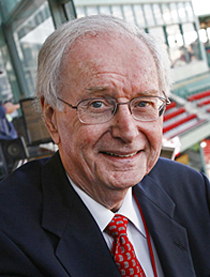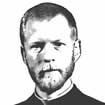
Culture

Flavin
I got to thinking about baseball caps the other night. That'll give you an idea of what an exciting life I lead -- I spend my evenings thinking about baseball caps.
I was watching a playoff game between the Milwaukee Brewers and the Los Angeles Dodgers (the Red Sox and the Astros were off) and the Brewers were wearing caps with an old team logo from 40 years ago on them -- the one that shows a baseball in a glove. I'll never forget the eureka moment that I had years ago when I suddenly realized that the logo was not just a baseball in a glove, but that the fingers on the glove formed the letter "M" and the the thumb and the leather around the ball was a lowercase "b". It wasn't just a baseball in a glove after all; it was a Milwaukee Brewers' baseball in a glove. Ever since then I've thought it was the coolest logo in all sports. I'll never understand why the Brewers changed it.
Baseball caps have always featured team logos or the letters of the cities they represent. The classic old English "B" on the Red Sox caps has doubled as the team's logo for as long as I can remember. For a while a few years ago the Red Sox, a night or two a week, used a cap with their alternate logo, hanging socks, on them; it wasn't long before they gave up the practice -- although it is not uncommon to see fans at the ballpark and around town wearing their hanging socks caps. The hanging socks are also on the left sleeve of the road uniforms.
The New York Yankees have always used the distinctive intertwined "N" and "Y" on their caps and home uniforms. The logo has stood the test of time for a good reason; it was designed by Louis Tiffany. One of Jacob Rupert's partners had been New York City police commissioner, and he had the design crafted by Tiffany for a police medal. He liked it so much that he brought it with him when he joined forces with Rupert to buy the Yankees and the logo has been in use since 1909. The only difference in the letters is that they have become somewhat larger on Yankee caps over the years.
Teams representing other cities with multiple words in their names (Los Angeles, St. Louis, et al.) have long since used interconnected letters on their caps.
Since 1947, the Cleveland Indians have from time to time used Chief Wahoo, their infamous cartoon character/logo on their caps. The Chief has been derided for years by many as demeaning to native Americans. Indians management finally gave in to their critics this year, and, once the Indians were swept by the Astros in the ALDS, he was retired, if not summarily executed; but he went out in style, plastered all over the team's caps and uniforms in those final games.
That's not the end of cartoon figures on caps, though. One of the caps worn by the Baltimore Orioles features a cartoon of an oriole. After the year Baltimore had, 115 losses and only 47 wins, one would think they'd be well advised to avoid putting cartoons on their caps. There are other major league caps that feature a variety of birds; some have fish; there is a rattlesnake, a halo, a compass, and a star.
The Oakland Athletics' baseball cap is the only one that has an apostrophe; it says, "A's". The team also wears a logo on its sleeve that depicts an elephant standing on a huge baseball and wielding a bat in its trunk. It doesn't make any sense until one looks up its history. In 1902, when the Philadelphia Athletics joined the American League, John McGraw of the New York Giants dismissed the new team as "a white elephant." The manager, none other than Connie Mack, defiantly decided to use a white elephant as the team's mascot, and thus the logo. The Philadephia A's moved to Kansas City in 1955; then 50 years ago the Kansas City A's moved to Oakland, which in turn, has been looking for a new home for years; but still the elephant mascot lives on, at least on the sleeves of the uniforms.
Some teams, the Red Sox, Yankees and Dodgers are examples, use only their classic caps during games although even they might use alternative versions in pre-game activities. Many of the others vary the design and colors of their caps. It's not done to win games, it's done to sell hats.
It's all about the marketing, of course. The selling of team caps, uniforms, jackets, and the like is a big business. Who would have thought that the lowly baseball cap, whose original purpose was to simply shade the eyes of players from the glaring summer sun, would become such a marketing Behemoth?
Everyone sells them now, not just baseball teams. Football teams, whose players wear helmets, sell baseball caps with the team logos on them. Hockey teams do the same. Basketball players play bareheaded, but their teams sell baseball hats. Businesses of all types and sizes use them as marketing tools, and so do charities. The president of the United States sells them, for cryin' out loud.
Is there anyone, anyplace who doesn't own at least one of them? I'd be willing to bet that, somewhere in the vast wardrobe of Queen Elizabeth, a wardrobe that includes ermine capes and gold-braided gowns, there are a couple of baseball caps. Same thing with the pope. Doesn't he strike you as the kind of guy who'd wear a baseball cap, maybe a white one, while puttering around the yard?
My fervent hope is that, when the expiration date of my time on the planet expires and I appear before St. Peter at the Pearly Gates to explain and defend my actions while on earth, he'll be wearing a Red Sox cap.
- Dick Flavin is a New York Times bestselling author; the Boston Red Sox “Poet Laureate” and The Pilot’s recently minted Sports’ columnist.
Recent articles in the Culture & Events section
-
Tolkien's world, still popular on the big screen, began with faith and wordsCecilia Hadley
-
Scripture Reflection for Dec. 22, 2024, Fourth Sunday of AdventDeacon Greg Kandra
-
Getting adult children to Christmas MassGreg Erlandson
-
The work of redemptionEileen McLaughlin
-
Intern reflectionsEmily Greco and James Kaeser


















